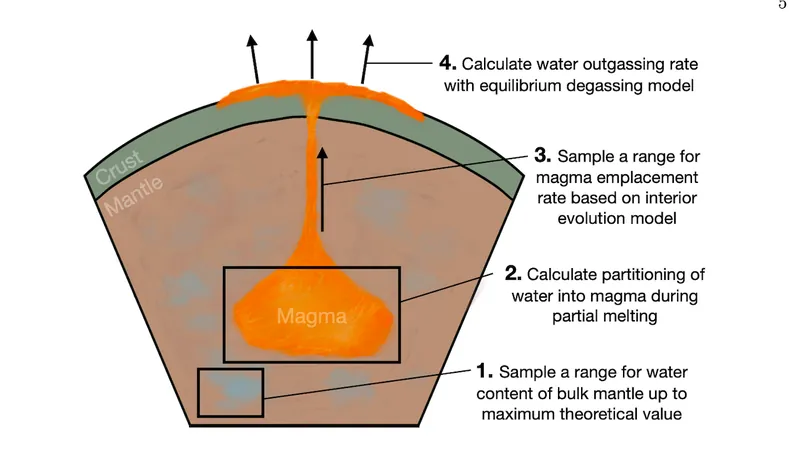
Unlocking the Secrets of TRAPPIST-1: Could Water Outgassing Sustain Life?
2025-05-08
Author: Siti
Exploring the TRAPPIST-1 Planetary System
The TRAPPIST-1 system has captured the attention of scientists eager to uncover whether planets orbiting M-stars can maintain atmospheres capable of supporting life. Recent observations from the James Webb Space Telescope (JWST) have already made waves by ruling out a thick CO2 atmosphere on TRAPPIST-1 c, yet the presence of atmospheric water vapor—and its vital byproduct, oxygen—remains tantalizingly possible.
The Vital Role of Water Outgassing
To keep water vapor in play, scientists believe a continuous source is essential, particularly considering the high rates at which atmospheres tend to escape. Enter volcanic outgassing, a potential hero for sustaining atmospheric water. Researchers have simulated water outgassing scenarios across a broad spectrum derived from terrestrial bodies in our solar system.
Narrowing Down the Possibilities
After running their simulations, scientists applied two rigorous filters grounded in observational and geochemical data. Their findings indicate that for all seven planets in the TRAPPIST-1 system, the water outgassing rates are likely around 0.03 times that of Earth’s, with possible upper limits soaring up to 8 times Earth's rate.
Implications for Planetary Conditions
This range suggests geological conditions not unlike Mars, boasting low rates of magma emplacement and relatively dry mantle compositions akin to Earth, with the possibility of mantle water contents reaching up to 1% by weight. Several scenarios, including those with magma activity comparable to that of Mars and Io, point to different water content preferences and outgassing rates.
A Long-Term Solution for Habitability?
Encouragingly, the estimated outgassing rates may be sufficient to counterbalance the rates at which water escapes, offering a theoretical lifeline for the TRAPPIST-1 planets to maintain surface water or at least atmospheres rich in water vapor over extensive periods. These insights into outgassing dynamics and interior characteristics could greatly enhance atmospheric chemistry models and escape theories, paving the way for exciting future observations of this intriguing planetary system, and possibly informing our understanding of distant exoplanets.
A Team of Experts Behind the Discovery
This compelling research comes from a dedicated team of scientists, including Trent B. Thomas, Victoria S. Meadows, Joshua Krissansen-Totton, Megan T. Gialluca, Nicholas F. Wogan, and David C. Catling, who are pushing the boundaries of our understanding of potential life-supporting environments beyond Earth.


 Brasil (PT)
Brasil (PT)
 Canada (EN)
Canada (EN)
 Chile (ES)
Chile (ES)
 Česko (CS)
Česko (CS)
 대한민국 (KO)
대한민국 (KO)
 España (ES)
España (ES)
 France (FR)
France (FR)
 Hong Kong (EN)
Hong Kong (EN)
 Italia (IT)
Italia (IT)
 日本 (JA)
日本 (JA)
 Magyarország (HU)
Magyarország (HU)
 Norge (NO)
Norge (NO)
 Polska (PL)
Polska (PL)
 Schweiz (DE)
Schweiz (DE)
 Singapore (EN)
Singapore (EN)
 Sverige (SV)
Sverige (SV)
 Suomi (FI)
Suomi (FI)
 Türkiye (TR)
Türkiye (TR)
 الإمارات العربية المتحدة (AR)
الإمارات العربية المتحدة (AR)